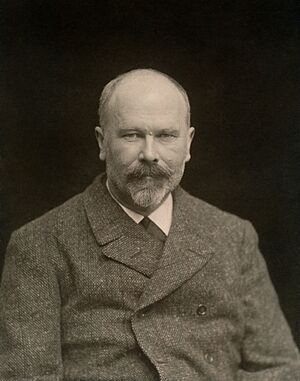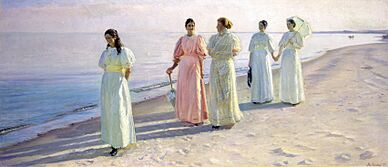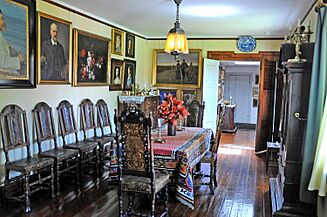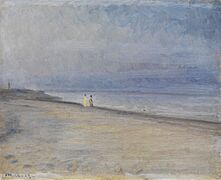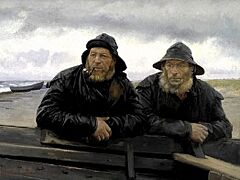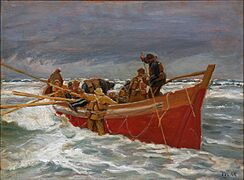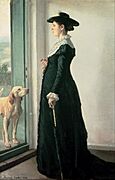Michael Ancher facts for kids
Michael Peter Ancher (born June 9, 1849 – died September 19, 1927) was a famous Danish realist artist. He was well-known for his paintings of fishermen and scenes from the Danish fishing village of Skagen. His art often showed the Skagerak and the North Sea.
Contents
Michael Ancher's Early Life and Art School
Michael Peter Ancher was born on the island of Bornholm in Denmark. His father was a local merchant. Michael went to school in Rønne, but he had to leave early. This happened because his family faced money problems. He needed to find work to support himself.
In 1865, he started working as a helper at Kalø Manor in Jutland. The next year, he met two painters, Theodor Philipsen and Vilhelm Groth. They were painting in the area. They saw Michael's early drawings and told him he should become a painter.
In 1871, he went to C.V. Nielsen's art school. Later that year, he joined the Royal Danish Academy of Art in Copenhagen. He studied there for some time but left in 1875 without finishing his degree.
One of his friends from art school was Karl Madsen. Karl invited Michael to visit Skagen. Skagen was a small fishing village in northern Jutland. It was a special place where the Skagerak and North Sea met.
Joining the Skagen Painters
Michael Ancher first visited Skagen in 1874. He loved it so much that he decided to live there. He joined a group of artists who gathered in Skagen every summer. They were known as the Skagen Painters.
These artists often met at the Brøndums Hotel in Skagen. They shared their ideas and talked about art. In 1880, Michael married another painter, Anna Brøndum. Anna was from Skagen, and her father owned the Brøndums Hotel.
When they first got married, Michael and Anna lived in a place called the "Garden House." This house is now part of the Skagens Museum. In 1883, their daughter Helga was born. After that, the family moved to a different house on Markvej in Skagen.
Michael Ancher's Art Career
Michael Ancher became famous in 1879 with his painting Vil han klare pynten (Will He Round the Point?). His artworks often showed the brave fishermen of Skagen. He painted their exciting and sometimes dangerous lives at sea. His style combined showing things as they really were (realism) with a classic way of arranging his paintings.
Some of his most important paintings include:
- The Lifeboat is Carried Through The Dunes (1883)
- The Crew Are Saved (1894)
- The Drowned Man (1896)
Michael Ancher learned a lot from his art training in the 1870s. This training taught him strict rules for how to arrange a painting. But marrying Anna Ancher also changed his art. She taught him to show reality exactly as it was, with all its natural colors.
By mixing his traditional training with Anna's ideas, Michael Ancher created a unique style. It was called modern monumental figurative art. This means he painted big, important pictures that showed people in a powerful way, like in his painting A Baptism.
You can see Michael and Anna Ancher's paintings in many places. These include the Skagens Museum, the Statens Museum for Kunst (National Gallery of Denmark), the Frederiksborg Museum, The Hirschsprung Collection, and Ribe Art Museum.
Michael Ancher received important awards for his art. He got the Eckersberg Medal in 1889. In 1894, he received the Order of the Dannebrog, which is a Danish order of chivalry.
Many of Ancher's paintings used to hang in the dining room of the Brøndums Hotel. Another painter, P.S. Krøyer, had the idea to put paintings by different artists on the walls. In 1946, this dining hall was moved to the Skagens Museum.
Michael and Anna Ancher's Home as a Museum
Anna and Michael Ancher bought their house in Skagen in 1884. In 1913, they added a large studio to the house. Today, you can visit both the house and the studio.
When their daughter, Helga Ancher, passed away in 1935, she left the house and everything inside it to a foundation. This foundation helps keep the house as it was.
In 1967, the home became a museum called the Anchers Hus. Inside, you can see the original furniture and paintings. These artworks were created by the Anchers and other Skagen artists.
The museum also has temporary art shows in another building on the property called Saxilds Gaard. This building displays more paintings by Michael and Anna Ancher. It also shows art by their friends from the Skagen Painters group. Today, the Anchers' home is part of Skagens Kunstmuseer.
On Danish Money
Anna and Michael Ancher were featured on the front of the old DKK1000 bill (a Danish banknote). The first version of this bill came out in 1998. It was updated in 2004 with more security features.
The banknote showed a double portrait of Anna and Michael Ancher. This image came from two paintings made in 1884 by Peder Severin Krøyer. These original paintings used to hang in the dining room at Brøndums Hotel.
Letters and Stories
A collection of nearly 4,000 letters between Michael and Anna Ancher and their friends was published. These letters, along with comments from an art historian, tell many stories about their lives. The collection is called Anna og Michael Ancher. Breve og fotografier 1866-1935 (Anna and Michael Ancher. Letters and photographs 1866-1935).
Paintings Gallery
-
Anna Ancher returning from the field
See also
 In Spanish: Michael Peter Ancher para niños
In Spanish: Michael Peter Ancher para niños
- Skagen Painters
- Lars Kruse



